Back


Poster Session A - Sunday Afternoon
Category: Stomach
A0707 - A Rare Hybrid gNET: The Neoplastic Jack of All "Grades"
Sunday, October 23, 2022
5:00 PM – 7:00 PM ET
Location: Crown Ballroom

Has Audio

Pranay Reddy, MD, MPH
Jefferson Health Northeast
Philadelphia, PA
Presenting Author(s)
Pranay Reddy, MD, MPH1, David Valadez, MD2, Mojtaba Olyaee, MD, FACG3
1Jefferson Health Northeast, Philadelphia, PA; 2University of Kansas Medical Center, Kansas City, KS; 3University of Kansas Medical Center, Leawood, KS
Introduction: Gastric neuroendocrine tumors (gNETs) are rare malignancies which arise from enterochromaffin-like cell (ECL) precursors within the gastric mucosa. There are 4 classifications of gNETs primarily based on size, number of lesions, serum gastrin level, tissue invasion, proliferation index and immunohistochemistry. Applying a combination of factors, gNETs are typically classified into one of these four categories with relative ease. The following case highlights an exceedingly rare hybrid presentation of gNET containing features of all four classification subtypes.
Case Description/Methods: A 78-year-old female with a past medical history of hypertension, diabetes mellitus, chronic kidney disease and gastroesophageal reflux disease (GERD) initially presented with worsening symptoms of GERD. The patient denied any alarm symptoms but did endorse persistence of reflux symptoms despite proton pump inhibitor use. Screening EGD with EUS showed polyps which were removed with mucosal resection. Initial pathology illustrated well differentiated gNET. She underwent a DOTA-TATE PET/CT scan which showed heterogenous uptake involving the gastric body reflecting focal gNET without evidence of metastatic disease. The patient underwent total gastrectomy and esophagojejunostomy with upper GI series revealing no evidence of anastomotic leak. On subsequent pathology, at least 46 semi pedunculated gastric polyps were identified of which the greatest tumor dimension was 0.6 cm with a mitotic rate less than 2 mitoses/2mm2. Pathology and immunohistochemistry revealed well differentiated gNET, grade 1 and 2, staining positivity for Chromogranin A (CgA), synaptophysin, CD56, and CAM 5.2 with a Ki67 proliferation index > 6%. Patient’s serum gastrin was within normal limits at 51pg/ml and 24-hour urine 5-HIAA revealed a normal level of 5.7 mg/24hr. She was referred to a geneticist for massive parallel sequencing also known as next generation sequencing (NGS).
Discussion: This case displays a rare, hybrid presentation of gNET with features of all four classification subtypes. The positive synaptophysin, normal serum gastrin and increased Ki67 index are characteristic of gNET Type 3 and 4 which carry a poor prognosis. Type 3 and 4 however, are typically large ( >2cm), single tumors. This patient had many, smaller tumors with positive CgA staining commonly seen in Type 1 and 2. Hybrid gNETs are extremely uncommon neoplasms which create both a diagnostic and therapeutic challenge requiring a truly multidisciplinary effort.

Disclosures:
Pranay Reddy, MD, MPH1, David Valadez, MD2, Mojtaba Olyaee, MD, FACG3. A0707 - A Rare Hybrid gNET: The Neoplastic Jack of All "Grades", ACG 2022 Annual Scientific Meeting Abstracts. Charlotte, NC: American College of Gastroenterology.
1Jefferson Health Northeast, Philadelphia, PA; 2University of Kansas Medical Center, Kansas City, KS; 3University of Kansas Medical Center, Leawood, KS
Introduction: Gastric neuroendocrine tumors (gNETs) are rare malignancies which arise from enterochromaffin-like cell (ECL) precursors within the gastric mucosa. There are 4 classifications of gNETs primarily based on size, number of lesions, serum gastrin level, tissue invasion, proliferation index and immunohistochemistry. Applying a combination of factors, gNETs are typically classified into one of these four categories with relative ease. The following case highlights an exceedingly rare hybrid presentation of gNET containing features of all four classification subtypes.
Case Description/Methods: A 78-year-old female with a past medical history of hypertension, diabetes mellitus, chronic kidney disease and gastroesophageal reflux disease (GERD) initially presented with worsening symptoms of GERD. The patient denied any alarm symptoms but did endorse persistence of reflux symptoms despite proton pump inhibitor use. Screening EGD with EUS showed polyps which were removed with mucosal resection. Initial pathology illustrated well differentiated gNET. She underwent a DOTA-TATE PET/CT scan which showed heterogenous uptake involving the gastric body reflecting focal gNET without evidence of metastatic disease. The patient underwent total gastrectomy and esophagojejunostomy with upper GI series revealing no evidence of anastomotic leak. On subsequent pathology, at least 46 semi pedunculated gastric polyps were identified of which the greatest tumor dimension was 0.6 cm with a mitotic rate less than 2 mitoses/2mm2. Pathology and immunohistochemistry revealed well differentiated gNET, grade 1 and 2, staining positivity for Chromogranin A (CgA), synaptophysin, CD56, and CAM 5.2 with a Ki67 proliferation index > 6%. Patient’s serum gastrin was within normal limits at 51pg/ml and 24-hour urine 5-HIAA revealed a normal level of 5.7 mg/24hr. She was referred to a geneticist for massive parallel sequencing also known as next generation sequencing (NGS).
Discussion: This case displays a rare, hybrid presentation of gNET with features of all four classification subtypes. The positive synaptophysin, normal serum gastrin and increased Ki67 index are characteristic of gNET Type 3 and 4 which carry a poor prognosis. Type 3 and 4 however, are typically large ( >2cm), single tumors. This patient had many, smaller tumors with positive CgA staining commonly seen in Type 1 and 2. Hybrid gNETs are extremely uncommon neoplasms which create both a diagnostic and therapeutic challenge requiring a truly multidisciplinary effort.

Figure: Ga-68 Dotatate PET-CT showing diffuse heterogenous uptake in the gastric body.
Disclosures:
Pranay Reddy indicated no relevant financial relationships.
David Valadez indicated no relevant financial relationships.
Mojtaba Olyaee indicated no relevant financial relationships.
Pranay Reddy, MD, MPH1, David Valadez, MD2, Mojtaba Olyaee, MD, FACG3. A0707 - A Rare Hybrid gNET: The Neoplastic Jack of All "Grades", ACG 2022 Annual Scientific Meeting Abstracts. Charlotte, NC: American College of Gastroenterology.
